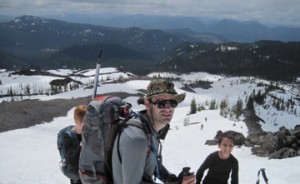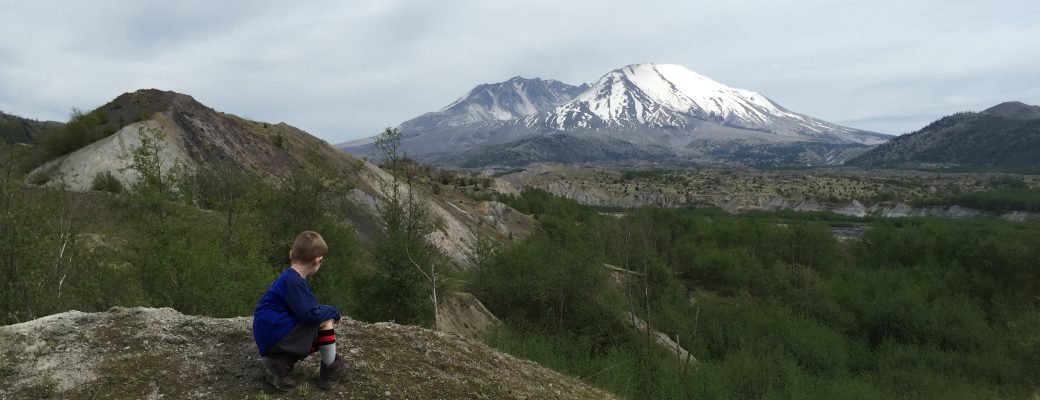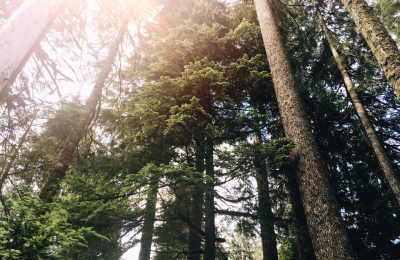The Lake Padden Park features several trails, most notably is the primary loop which wraps around the lake itself. This 2.6 mile loop is an easy hike with several minor hills and compacted gravel as a surface. On warm summer days you'll find swimmers using some of the multiple lake access points along the route.
Mt. St. Helens Hike Experience
Hiking Mt. St. Helens
– By Nic Poe
Mt. St. Helens? No problem, I thought to myself. After all, I played basketball several hours a day, I was a teenager, I could do anything. Oh the painful lessons one learns in his youthful arrogance. At this point in my life, I had been on a single hike.Despite growing up a mere thirty miles from the site of perhaps the most famous volcanic eruption in of the past one hundred years, I’d managed to go about my daily life without even giving a single thought to the idea of climbing to the top.
“Don’t we need mountain climbing gear?” I asked my cousin Damon.
“No,” he replied, obviously amused by my lack of mountaineering prowess.
Damon had been in the military for a year and was home on a short leave. An experienced hiker, he’d invited my brother Mike, cousin Derek, and good friend Brandon along on the hike as well. As the day of the climb drew closer I had begun to get nervous, as I suddenly realized I had no idea what I was in for. I didn’t even own hiking boots! Luckily for me, the hike up Mt. St. Helens isn’t even remotely technical in comparison to some of the other great peaks in the Cascade Range. Before the famous eruption on May 18th, 1980, the beast of a mountain stood 9,677 feet high. Sadly, on that fateful day back in 1980, the mountain claimed the lives of 57, along with over 1,314 feet of elevation.

I was born a year after the blast, but the aftermath of this devastating eruption left many artifacts. My older brother Dustin was only two years old when it happened. Ash covered the sky, polluting the air to the point that people wore masks when they went outside. They were basic hospital masks. The white ones that covered the nose to the chin, with a simple rubber strap to hold it in place. For years my brother’s mask sat on the shelf in my grandmother’s Kelso, Washington home. My mother had drawn a smily face on it to try to make it seem less frightening. Growing up, many of my friends told stories about these masks, or stories about the ash that remained under their homes until decades later. This was all just a normal part of living within miles of a volcanic blast zone. Although it was scary to think about the destruction that it caused, the idea of walking to the top of such an incredible example of nature’s awesome power gave me chills.
When planning a hike up St. Helens there are a few significant details to keep in mind. Peak climbing months occur in July and August, but permits are required to climb the mountain beginning on May 15th. Monitor Ridge is the name of the most popular way up the mountain. Some people take a lesser utilized path by the name of Loowit, but the most common trail is Monitor Ridge. Climbing is limited to 100 climbers per day, so climbing requires planning well in advance. Tickets can be purchased online beginning February 1st. Having reached the summit four times I can say without a doubt it is absolutely necessary to purchase passes as soon as they become available on February 1st. Weekends fill up quick, and weekdays in the summer months start to dwindle very soon.
People often ask me when is the “best” time to go. This is difficult question to answer because it depends largely on the preference of the individual. For example, if you absolutely hate getting sun and wind burn, then July and August are definitely not for you, but if you don’t mind covering yourself in sunscreen multiple times up then a summer hike can be extremely rewarding. Another advantage to hiking St. Helens in the summer is assurance that you will be able to drive the entire way up to Climber’s Bivouac, the campsite at the trailhead. On the other hand, if you love the snow, and want to experience the incredible joy that is glissading on your backside down snowy Mt. St. Helens, then April to May might be the best time for you. This is actually my preferred time to hike up the mountain but it often requires several additional miles of hiking as Climber’s Bivouac is often snowed out several miles before the trail head.
On my first trip up the mountain which I referred to earlier, we arrived at Climber’s Bivouac around 9:00pm with no issues the night before our climb. We had purchased our tickets online, and gathered our passes so we’d be able to park our 1992 Bronco at the campsite. My cousin Damon and Brother Mike put up a tent, while my friend Brandon and I slept in the back of the Bronco. For this trip, the weather was sunny the entire way up. The trail itself begins in a woodsy area for the first hour or so, until you reach a clearing and the enormous mountain comes into full view. This is the point when you really find out what you are made of. With each hour it seems as if you are nearing the top, but the visual can be very deceiving. What often looks life several hundreds yards can take hours due to the rocky terrain, and steep uphill climb. On my first trip up, it took us about four hours to get to the top. I’ll never forget the incredible satisfaction of reaching the top of my first mountain. Luckily the skies were clear so everywhere I looked there were other mountains in the Cascade range. Of course, I can not neglect to mention the crater. It’s quite a sight when you first reach the top to look down into the crater. It’s a magnificent example of the power of nature to consider just how much of the mountain was sent into the atmosphere on that historic day decades ago. If you are lucky, you will see the steam that still bursts out of the crater from time to time. Overall, I would say my first experience climbing the mountain was the best, but later trips were easier on my body because I was much more prepared, and the times I went in the snow didn’t take as much of a toll on my easily sun-burned skin. Regardless of your fitness level, plan on spending the entire day on this hike. In the winter it can take up to seven hours to the top, and you’ll definitely want to hang out at the crater for a while to celebrate your achievement.

Resources for Mt. St. Helens Hikes
View the Mt. St. Helens Visitor Map (PDF).
Here is all the information you need to acquire a Mt. St. Helens Climbing Permit.
The US Forest Service website has a wealth of resources on the topic of climbing Mt. St. Helens. How to obtain a permit, information and frequently asked questions, as well as Mt. St. Helens climbing preparation and safety concerns.




This Post Has 0 Comments